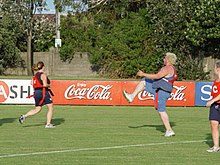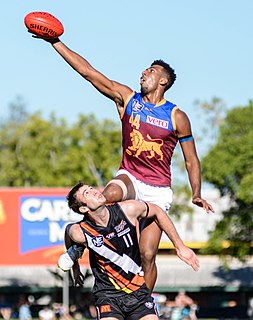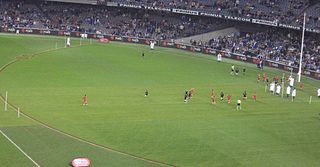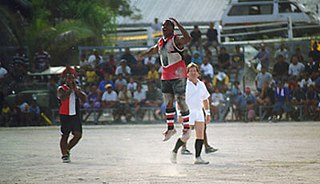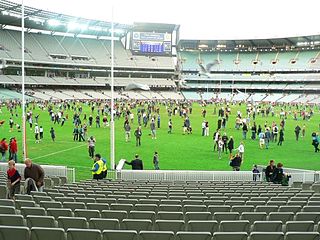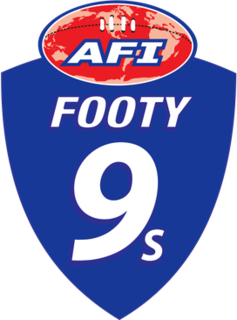Participatory varieties
Auskick

Auskick is a program developed in Australia in the 1980s and promote participation in Australian rules football amongst children, particularly of primary school age and under. It has proven to be popular with both boys and girls. At its peak in the mid-1990s there were around 200,000 Auskick participants annually. [1] The program is now run throughout the world, including several locally branded variations such as: "Kiwi Kick" (AFL New Zealand), "Niukick" (Papua New Guinea), "Footy Wild" (South Africa), "Bula Kick" (Fiji), "Viking Kick" (Denmark) and "Ausball" (United States) among others.
Auskick has its roots in the Little League which began to be played at half time during VFL matches in the 1960s [2] and was revised in 1980 to make it more accessible. Little League was expanded by Ray Allsop into a state development program called Vickick begun in Victoria in 1985. Urged by former player David Parkin in 1995 as a means of keeping the sport viable long term in the Australian Capital Territory [3] it was adopted by the AFL Commission the national governing body for the sport, which began to roll it out nationally from 1998. Numerous professional players are graduates of the Auskick program.
Women's Australian rules football

Women's Australian rules football is a fast-growing variation played by all-female teams that dates back to the 1910s. Since 2010, it has also been governed by the AFL Commission. Its highest levels of competition are the professional AFL Women's club competition in Australia and the Australian Football International Cup (women's division) worldwide representative competition.
The women's game is also a contact sport, however over the course of its history it is sometimes played with modified rules including different player numbers (16 a side + 5 interchange), a smaller ball, and increased tackling restrictions. The women's variation is strongest in Australia (there are strong second level competitions in all Australian states), Ireland, Canada, the United States, United Kingdom, New Zealand and Japan and is also played at junior level in these and many other countries.
Amateurs

The Amateur version of the game is mostly similar though its main differences are that it strictly forbids player payments and has some rule variations which encourage participation for amateur players. Amateurs is strongest in the heartland states of the sport in Australia: Victoria, South Australia and Western Australia, though there are competitions in most Australian states. The Amateur version is governed by the Australian Amateur Football Council. Notable rule differences include the order-off rule which has been a feature of play since the 1930s, [4] and the use of a shorter distance penalty, the 25-metre penalty, among others, including shorter quarters and increased numbers of interchange players for some grades. The Australian Football International Cup, while being run by the AFL Commission, has for most of its history been aligned with Amateur rules acknowleding the fact that most of the leagues outside of Australia were until recently dominated by amateur players.
Masters Australian Football
Masters Australian Football (also known as "Superules" or derisively as "Superfools") is an amateur social variation for players aged 35 years and over. The sport first commenced officially on 21 September 1980 in Ballarat, Victoria. Masters matches are typically classified by age grades: Supers (35+ years); Masters: (40+ years) and Seniors: (45+ years); Super Seniors (50+) and Super Veterans (55+) [5] and some matches either do or don't allow mixing between these age groups. Masters leagues often also incorporate rules from Amateurs football.
The game varies from open age football particular in modifications aimed at reduce the physical impact of the game on older players and reduce the volunteer burden on officials. Umpires do not bounce the ball and there are often no boundary umpires. There are less interchange restrictions and players are not permitted to raise their knees in aerial contests, or make contact with the knee or boot, which could potentially damage the weaker backs of older players. [6]
Some Masters competitions add bonus points for a long range Super goal (9 points 6 plus 3 behinds).
It is played by over 119 teams throughout Australia and around the world. There is also an Australian National Championships, while internationally, Masters is more often be played in the Nines (9-a-side) format.
Lightning football
Lightning football is a generic term to describe variations of the game played over a shortened length, usually about half of the length of a full match. Lightning football may be played under otherwise unchanged rules, but in recent lightning matches staged by the AFL, experimental rules such as awarding a free kick against the last player to touch the ball before it goes out of bounds have been trialled.
Lightning matches are often used, particularly at junior or amateur level, to play an entire tournament inside a single day or weekend. These tournaments are typically known as "lightning premierships" or "lightning carnivals".
During the COVID-19 pandemic the AFL significantly shortened premiership matches for the 2020 AFL season arguing it needed to for its pandemic fixture scheduling leading to some branding the 16 minute quarter format 'fast food footy'. [7] Some argued the AFL's move was an effort to make the game more appealing to the media and fans. [8] Nevertheless, the move was criticised [9] and the AFL reverted to the full length format for the 2021 AFL season.
Wheelchair
The wheelchair variation of AFL (known as "Wheelchair Aussie Rules" or "Wheelchair AFL") is a parasport designed to play in sports wheelchairs. Kicking is replaced by handballing (a mark is awarded for catching the ball within 3 metres), while handballing is replaced by throwing. Like other varieties tackling is replaced by touching and players are divided into zones. Goals and behinds are used for scoring, however with shorter distances between the posts. There are leagues operating in all states and territories of Australia, with Victorian clubs aligned with AFL clubs, operating since 2018. [10] [11] [12]
